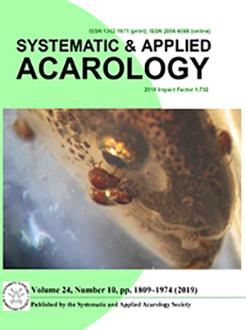Ioana Cristina Constantinescu, Gabriel Bogdan Chişamera, Daniel R. Gustafsson, Fasheng Zou, Xingzhi Chu, Costică Adam
Systematic and Applied Acarology 24 (10), 1851-1867, (7 October 2019) https://doi.org/10.11158/saa.24.10.5
KEYWORDS: feather mites, Analgoidea, Pteronyssidae, systematics, morphology
Two new pteronyssid feather mite species are described from passeriform birds in China: Pteroherpus pomatorhinaesp. nov. from the Streak-breasted Scimitar-babbler Pomatorhinus ruficollis Hodgson (Passeriformes, Timaliidae), and Pteroherpus chinensissp. nov. from the Collared Finchbill Spizixos semitorques Swinhoe (Passeriformes, Pycnonotidae). Pteroherpus pomatorhinaesp. nov. belongs to the diploplax species group. The males of Pteroherpus pomatorhinaesp. nov. have the prodorsal shield elongated, the opisthosoma narrowed to posterior end, the opisthosomal lobes slightly elongated, and two pairs of small additional sclerites (one dorsally, between prodorsal and hysteronotal shield, and one ventrally posterior to genital apparatus). The females of Pteroherpus pomatorhinaesp. nov. have a pair of anterior hysteronotal sclerites, a central sclerite, a pair of lateral opisthosomal sclerites partially split into lateral and inner fragments and a pair of pygidial sclerites. The central sclerite has almost parallel lateral margins and concave posterior margin, and the posterior ends of the fragments of opisthosomal shields are connected by a thick bridge. Pteroherpus chinensissp. nov. belongs to the hoplophorus species group. The males of Pteroherpus chinensissp. nov. have prodorsal shield slightly longer than wide, the opisthosoma moderately narrowed to posterior end, the opisthosomal lobes wide and short and the adanal shield with irregular form. The females of Pteroherpus chinensissp. nov. have the anterior hysteronotal sclerite fused with the prodorsal shield into a complex shield, a central sclerite, a pair of lateral opisthosomal sclerites and a pair of pygidial sclerites. The central sclerite is well delimited, and shaped as a longitudinal plate, slightly narrower posteriorly, with slightly convex anterior margin, concave lateral margins, and strongly convex posterior end.

